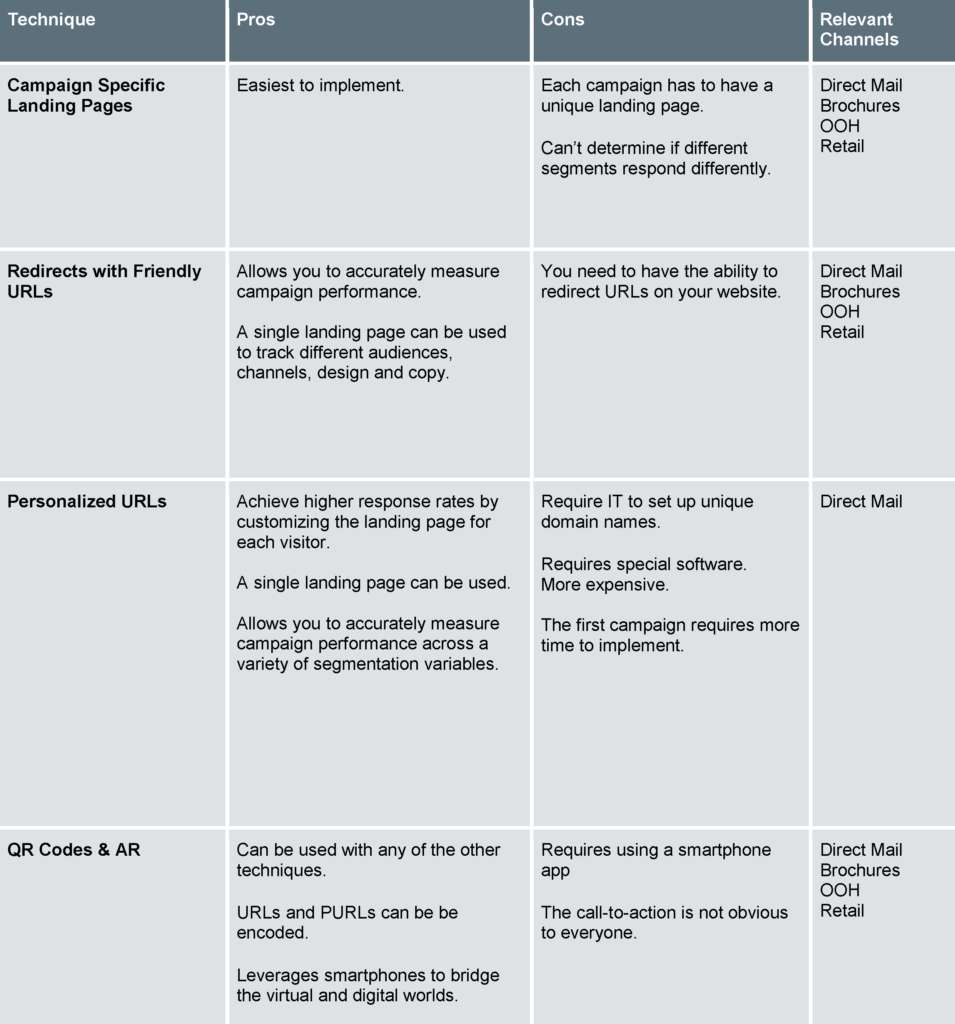
The internet has certainly changed many aspects of our lives. We turn to it for entertainment, for news, to research products and vacations, and get directions of all types. But perhaps the biggest change is the impact it’s had on marketing.
The internet brought the age of digital marketing with highly focused audiences, and immediate responses that can be measured in real time. But along with this comes information overload. The American Marketing Association figures the average American sees up to 10,000 ads in any given day! (source: AMA)
Leverage print to break through the clutter.
To measure print marketing performance you can use call tracking phone numbers specific to your campaign or use digital call-to-actions that can be measured using Google Analytics. For more technical details on using Google Analytics read my Measure to Improve Your Marketing Performance article.
Here’s three ways to track the marketing performance of print.
1. Campaign Specific Landing Pages
Avoid using a homepage for the call-to-action of any printed piece. Using a campaign specific landing page allows you to determine the response rate for your campaign and determine how visitors interact with your website.
Use a landing page with an URL like www.yoursite.com/winter-sale.
Since prospects reading a printed piece need to type in the URL in their browser, the URL should be:
- Easy for a person to type without typos
- Use term(s) related to the campaign
2. Use Redirects With Friendly URLs
This looks the same like method #1, but it leverages the power of Google Analytics to get many more details about your campaign effectiveness. You can answer questions like:
- What were the direct mail response rates for our house marketing list and a purchased list?
- How did direct mail compare to our email marketing for the campaign?
- How much revenue was driven by direct mail or email?
This techniques requires:
- A landing page like www.yoursite.com/winter-sale-landing-page
- A separate URL with Google Analytics UTM parameters that redirects the browser to the landing page.
An example is to use a URL like modernostrategies.com/measure-print that your website redirects a browser to:
In this example, the UTM parameters tell Google Analytics that in the campaign pmc-directmail, the source is guest-blogging, the medium is printmediacentr, and it is version-a of the content.
Here’s some sample parameters you can use for your print campaigns:
| Medium (Marketing Channel) | Source | Content (optional) |
| direct-mail | house-list | version-a |
| product-brochure | purchased-list | version-b |
| company-brochure | url | |
| retail-graphics | qr-code | |
| ooh | ||
| magazine-ad |
To implement different versions of the parameters you just need to create a different URL, such as /winter, /winter-sale/, /january-sale, for each combination.
You can implement URL redirection using a plugin on a WordPress website, and there’s other techniques are available for websites built on other platforms.
3. Personalized URLs
Using a personalized URL, or PURL, in your campaign allows you to:
- Conduct detailed segmentation analyses. Since you know individual behavior your can analyze performance using any data you have, such as industry, company size or job title.
- Increase response rates by providing personalized landing pages for each prospect.
- Learn what your prospect is interested in by tracking what pages they visit.
There are multiple services available to commercial print providers that allow you to create a unique URL, like like winter.yoursite.com/todc, for each person in your marketing list. Cross-channel marketing platforms like Mindfire and EasyPurl allow you to create the PURL call-to-action as well as landing pages and integrate email marketing. They also have built in campaign performance reporting.
Other services like purlem create the PURLs, allowing that you can then implement using your own website technologies.
Setting up a PURL campaign The disadvantages mostly affect only your first campaign. Once implemented, you can create subsequent campaigns just as easily as the other techniques.
QR Codes & Augmented Reality
QR codes and Augmented Reality (AR) can be used with any of the three techniques. URLs can be encoded in QR codes, and AR can either encode a URL in an image or use pattern recognition technology to send a smartphone app to the the web page.
While Augmented Reality can create a much richer, interactive experience, a disadvantage is that it requires a smartphone app. QR Codes have been around for years and have yet to achieve widespread adoption, but Apple and Google are making the technology more accessible on their smartphone platforms.
Summary of Measurement Techniques

Use the techniques in this article whenever you are using a website as the call-to-action for any printed piece so you can measure marketing performance.












One Response
very nice… i really like your blog…